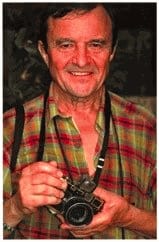
Photographer Dan Budnik’s five decade career encompasses photographs of major Abstract Expressionist and Pop Artists at work, key events of the Civil Rights movement, the Hudson River restoration effort, and Native Americans in the Southwest. Budnik grew up on Long Island, New York. At 17, he moved to the Los Angeles area to live with a sister. He graduated from high school and returned east to study painting at the Art Students League of New York. In 1952, his teacher Charles Alston showed him a book of photographs, The Decisive Moment by Henri Cartier-Bresson, and everything changed. Budnik was drafted into the Army in 1953, serving until 1955. He used his mustering-out pay to buy a Leica IIIf camera at a pawnshop.
In 1957, he started working at Magnum Photos in New York, assisting several photographers, notably Cornell Capa, Burt Glinn, Eve Arnold, Ernst Haas, Eric Hartmann and Elliott Erwitt. In March 1958, Budnik travelled to live with the “underground” in Havana for 6 weeks during the Cuban Revolution. Budnik continued to work with Magnum for half of his time, until joining as an associate member in 1963. In 1964, he left Magnum to go freelance, doing photo essays for leading national and international magazines.
Beginning in 1970, Budnik worked with the Hopi and Navaho nations of Arizona, and also became involved with his friend, folk singer and political activist, Pete Seeger’s efforts to clean up the Hudson River. Budnik won a National Endowment for the Arts Grant in 1973 for his work in Arizona, and a Polaroid Foundation Grant in 1980. In 1998 he was the recipient of the Honor Roll Award of the American Society of Media Photographers. Dan Budnik passed away in Tucson, Arizona in 2020.
